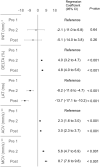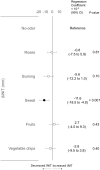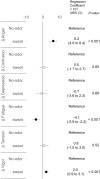Psychological states affecting initial pupil size changes after olfactory stimulation in healthy participants
- PMID: 37749199
- PMCID: PMC10520065
- DOI: 10.1038/s41598-023-43004-1
Psychological states affecting initial pupil size changes after olfactory stimulation in healthy participants
Abstract
Odor perception affects physiological and psychological states. Pupillary light reflex (PLR) parameters can be affected by olfactory stimulation and psychological states, although it remains unclear whether the olfactory stimulation-induced psychological changes can associate with PLR parameter changes. This study aimed to investigate effects of olfactory stimulation-induced psychological changes on PLR parameter changes with repeated measurements. We collected data on six mood subscales of the profile of mood states, and on five PLR parameter measurements from 28 healthy participants. Participants underwent a 10-min olfactory stimulation on different days with six odorants available with the T&T olfactometer. As obtained data were clustered, we used linear mixed-effects models for statistical analyses. The olfactory stimulation using the no-odor liquid did not affect mood states and the initial pupil size (INIT). The sweat odorant worsened all mood subscales including fatigue-inertia (Fatigue)/Vigor-Activity (Vigor), and decreased INIT compared to the no-odor liquid. When comparing INIT responses related to changes in mood subscales between the no-odor liquid and the sweat odorant, worsened states of Fatigue/Vigor were associated with decreased INIT in the sweat odorant. Fatigue/Vigor can be used as mental fatigue indicators. Thus, mental fatigue can be associated with decreased INIT in the olfactory stimulation.
© 2023. Springer Nature Limited.
Conflict of interest statement
The authors declare no competing interests.
Figures







Similar articles
-
Decreased initial pupil size and shortened constriction latency due to negative mood states and mental fatigue in clinical subacute pain models.Physiol Behav. 2022 Sep 1;253:113850. doi: 10.1016/j.physbeh.2022.113850. Epub 2022 May 19. Physiol Behav. 2022. PMID: 35598830
-
Recommendation of using both initial pupil size and constriction latency in pupillary light reflex as objective indicators reflecting subacute pain-related mental fatigue.Int J Psychophysiol. 2023 Mar;185:19-26. doi: 10.1016/j.ijpsycho.2023.01.008. Epub 2023 Jan 17. Int J Psychophysiol. 2023. PMID: 36669648
-
Involvement of the olfactory system in the induction of anti-fatigue effects by odorants.PLoS One. 2018 Mar 29;13(3):e0195263. doi: 10.1371/journal.pone.0195263. eCollection 2018. PLoS One. 2018. PMID: 29596487 Free PMC article. Clinical Trial.
-
The perception of odor is not a surrogate marker for chemical exposure: a review of factors influencing human odor perception.Clin Toxicol (Phila). 2013 Feb;51(2):70-6. doi: 10.3109/15563650.2013.767908. Clin Toxicol (Phila). 2013. PMID: 23387344 Review.
-
Odor discrimination by G protein-coupled olfactory receptors.Microsc Res Tech. 2002 Aug 1;58(3):135-41. doi: 10.1002/jemt.10131. Microsc Res Tech. 2002. PMID: 12203691 Review.
References
Publication types
MeSH terms
LinkOut - more resources
Full Text Sources
Medical
Research Materials

